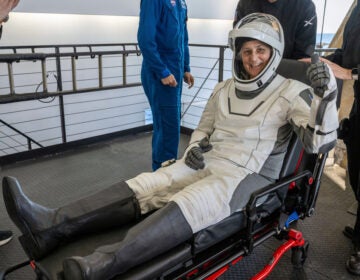The life and death of daredevil ‘Mad Mike’ Hughes
The daredevil known as “Mad Mike” Hughes died in a rocket crash in 2020. He was an amateur rocket builder on a quest to prove that the Earth is flat.
Listen 12:06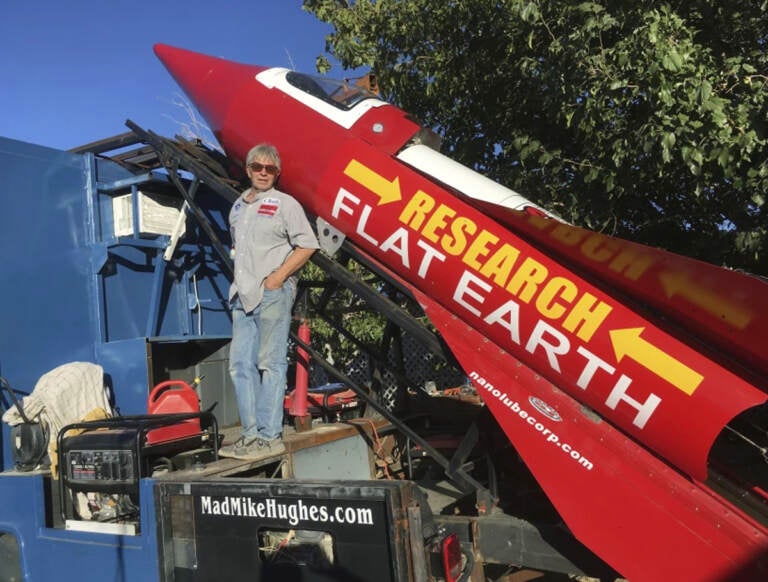
A 2017 photo shows daredevil “Mad Mike” Hughes with his steam-powered rocket constructed out of salvage parts. (Waldo Stakes / AP)
This story is from The Pulse, a weekly health and science podcast.
Find it on Apple Podcasts, Spotify, or wherever you get your podcasts.
It takes a certain kind of person to build a rocket and launch themself inside it. “Mad Mike” Hughes was a limousine driver turned stuntman. What made him famous was not just his homemade rockets, but why he wanted to build them: to shoot himself to the edge of space, to prove that the Earth is flat.
Hughes’ third and final rocket launch, on February 22, 2020, ended in his death at the age of 64.
Freelance journalist Justin Chapman is writing a book about Hughes, and was at the final launch in the desert outside Barstow, Calif.
“There were about 50 spectators there,” Chapman said. “There were a couple of live streamers, like YouTubers, some Flat Earth folks, and there was a TV crew that was filming the launch for a Science Channel show called ‘Homemade Astronauts.’”
Mad Mike Hughes just launched himself in a self-made steam-powered rocket and crash landed. Very likely did not survive. #MadMike #MadMikeHughes pic.twitter.com/svtviTEi8f
— Justin Chapman (@justindchapman) February 22, 2020
When the rocket took off, it hit a ladder propped up next to it, tearing off one of the parachutes. The rocket soared in an arc, it disappeared into the sky for a moment, and then started to fall.
“And as it’s coming down, everyone started realizing that his parachutes weren’t coming out. Even if they had, at this point, it was going to be too late. And he nose dived directly into the desert floor,” Chapman said.
“It was like a lawn dart, and hit the ground at somewhere between four and 500 miles an hour,” said Waldo Stakes, Hughes’ close friend and collaborator. Stakes taught Hughes how to build rockets.
This launch was really supposed to be a publicity stunt, not the last run. Hughes and Stakes built the rockets out of spare parts. They were hoping to attract investors for their ultimate goal: building a “rockoon,” a part-rocket, part-balloon that could launch Hughes 62 miles up to the Kármán line, the border between Earth’s atmosphere and outer space, before he’d parachute back down.
“The idea was to make Mike the greatest daredevil of all time – undisputed. He went to space and we built it in our backyard,” Stakes said. “The ability to build this stuff is never beyond your reach.”
Hughes hoped that he could see what shape the planet really was at that altitude.
“The Flat Earth thing is like everything else to me. I just want people to question everything,” Hughes said in an interview on CBS.
Michael ‘Mad Mike’ Hughes tragically passed away today during an attempt to launch his homemade rocket. Our thoughts & prayers go out to his family & friends during this difficult time. It was always his dream to do this launch & Science Channel was there to chronicle his journey pic.twitter.com/GxwjpVf2md
— Science Channel (@ScienceChannel) February 23, 2020
Hughes, who grew up in Oklahoma City and worked as a limo driver for years, embraced a lot of conspiracy theories, expressing skepticism about everything from science and gravity, to the moon landing and that the planes brought down the World Trade Center on 9/11.
Stakes says Hughes wasn’t dumb, and while he did believe the Earth is flat, he was using that story for the added attention it brought him.
For the last decade of his life, Hughes lived on a ranch that Stakes owns, down a long sandy road near the desert town of Apple Valley, about 90 miles northeast of Los Angeles. The name “El Ranchito Rakete” is inscribed above the gate, with steer horns and a horseshoe. Vehicles in various states of construction are scattered around.
Stakes is known in the daredevil community for designing and building rocket-powered cars and boats that break speed records. He first heard about Hughes and his homemade rocket through a friend back in 2008, and gave him a call. Hughes invited him to see the rocket.
Stakes says he gets lots of calls from people wanting to build rocket-powered vehicles, once they can raise funds. He was intrigued that Hughes had gotten as far as he did. But when he saw the rocket, he told Hughes the rocket would kill him. Stakes says Hughes then asked him to teach him how to make a rocket that would prevent that outcome.
At the ranch, next to a double-wide mobile home, Stakes has created a makeshift museum stored inside five shipping containers. They’re filled floor to ceiling with memorabilia devoted to fast cars, boats, and planes. There’s an entire shipping container about daredevils.
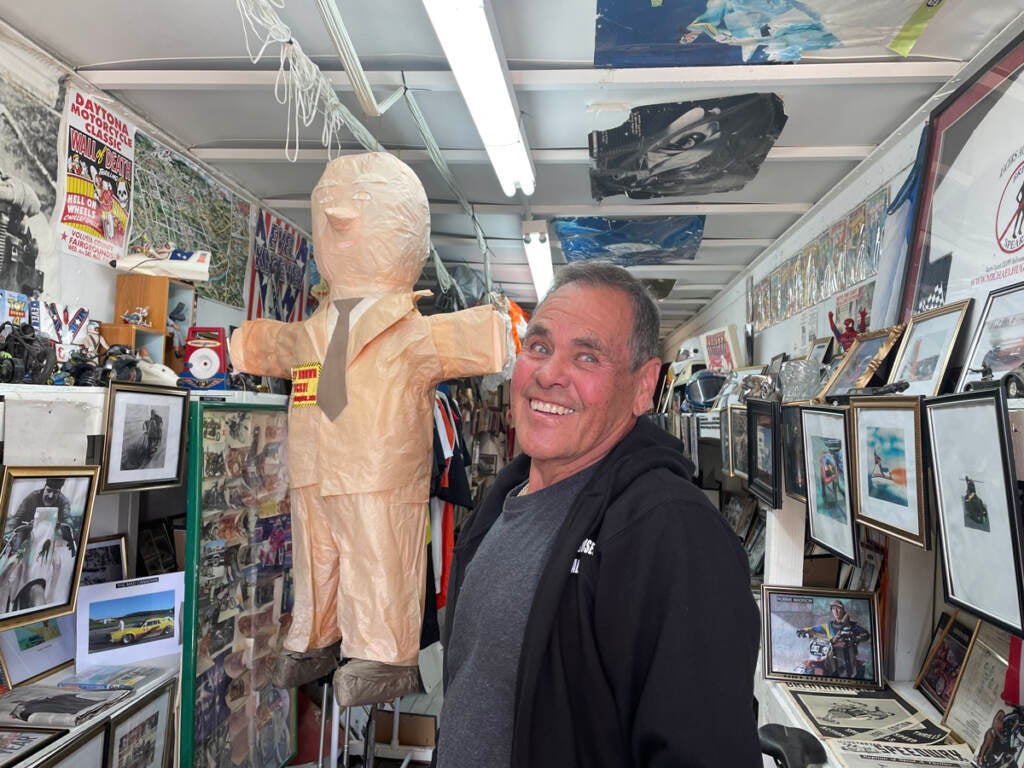
“This is basically a museum dedicated to people who did amazing stuff,” Stakes said.
There are framed photos and magazine covers, kids’ toys, and even a couple of antique motorcycles harkening back to daredevils past.
The years following World War I and II saw an upswing in people wanting to pull off dangerous stunts. Stakes’ museum includes old photos of daredevils hanging from trainer aircraft, playing tennis on the wings of a plane, and racing cars on the Bonneville salt flats.
There are figurines and posters of Evel Knievel, famous for his nationally televised motorcycle jumps. Stakes even has a photo of himself on display, hanging out of the back of a B-25 bomber at 250 miles an hour and at 5,000 feet in the air. “I took a selfie. I anchored myself, and hung my body out of the airplane and basically was held there by the airflow,” Stakes said.
This kind of behavior might seem insane to most of us. But throughout history, Stakes points out, innovative risk takers have driven some of our greatest advancements in travel. Glenn Curtiss built and raced bicycles and motorcycles before he became the leading American manufacturer of aircraft and the pioneer of flying boats. Henry Ford raced cars before starting his own automobile company.

The entire back section of the daredevil exhibition is like a memorial to “Mad Mike” Hughes and his stunts. There are parachutes and parts of rockets, framed photos of Hughes and the crew, and even a cocktail shaker containing some of Hughes’ cremated remains. All these objects speak to a life lived to the extreme.
“He held the Guinness Book of World Records for the longest limousine jump. He started out as a dirt bike racer, and he was really good. In fact, he won so many championships and stuff, he would throw the trophies away. He didn’t care about that. He just cared about the prize money and the trophy girl,” Stakes said.
Subscribe to The Pulse
According to Stakes, Hughes had a strong work ethic, building rockets from morning to night without interruption. Stakes recalls a previous rocket launch that nearly killed Hughes and left him using a walker for months. “Once he could walk, he started building his next rocket. He just was not going to stop. He figured that he was going to get famous enough that he was gonna run for governor,” he said.
Hughes often spoke about wanting to inspire people to follow their dreams, says Justin Chapman. But he also wanted fame, Chapman said, “so much so that it killed him.”
“He was disappointed as life went on that his name didn’t catch on the way Evel Knievel’s did, even though he was doing these extreme stunts.”
Toby Brusseau, the director of the documentary “Rocketman: Mad Mike’s Mission to Prove the Flat Earth,” said he wanted to paint a sympathetic picture of Hughes and his efforts.
“In the film we wanted to find the pathos of Mike, the relatability, and challenge people to see him as a person, rather than this crazy conspiracy theorist,” Brusseau said. “Because when it comes down to it, regardless of your belief, we all need a win in our lives, and Mike deserved a win.”
But Hughes never got that win, and it’s hard to ignore the role conspiracy theories played in his death.
“The conspiracy stuff radicalized him, like so many people have in the past few years, he did his ‘own research’ on YouTube,” Chapman said. “Mike is a perfect example of the logical end point of that kind of radicalization.”
Stakes sees it differently. The more famous Hughes became, “the more difficult he became, the more headstrong he became.”
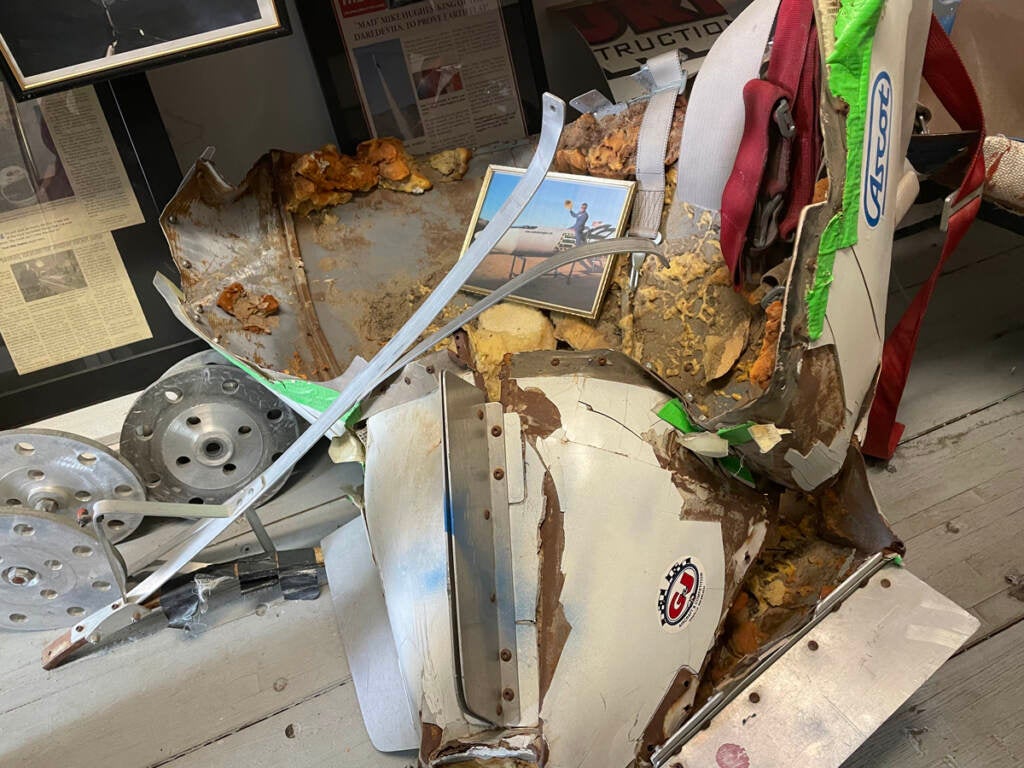
Hughes insisted on adding a metal ladder to get into the rocket, even though Stakes and the team warned him that it would interfere with the launch.
“What killed him was he didn’t listen to Waldo and his team about some pretty basic safety measures,” Chapman said.
Hughes also refused to add automatically deploying parachutes to the rocket.
“He told Waldo, ‘I’m a daredevil. If I can’t pull the parachutes myself, I deserve what I get,’” Chapman said.
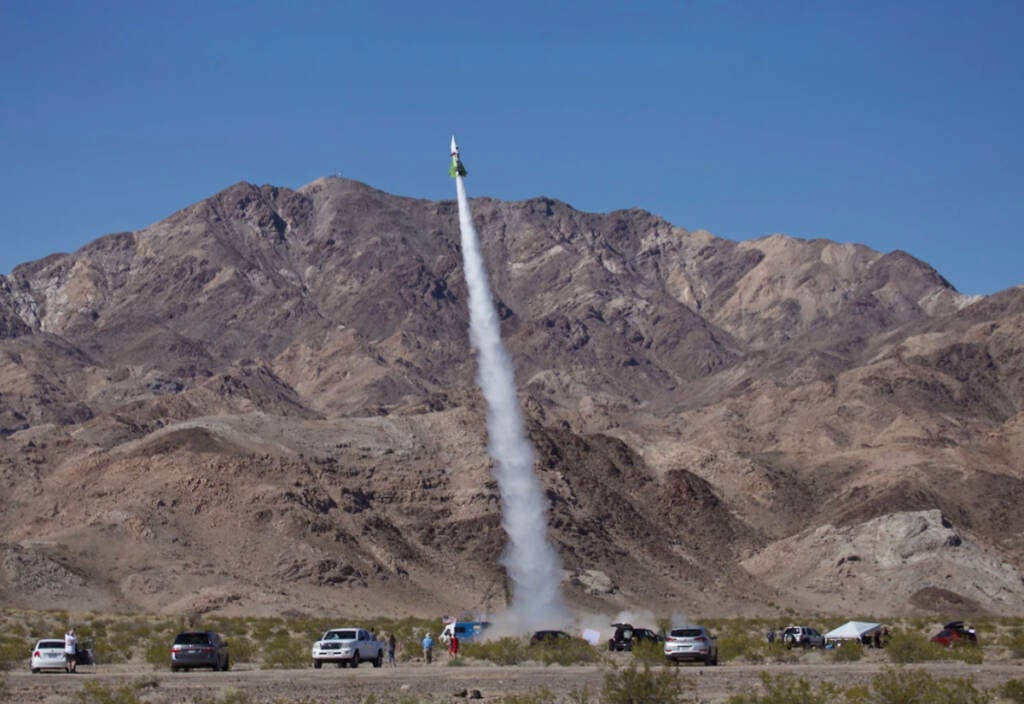
Stakes says Hughes knew the risks he faced. But he kept getting back in the rocket.
“Every time you get in one of these things, it’s a 50/50 chance. You take those dice in your hand and you roll. Sometimes it comes up snake eyes,” Stakes said.
Stakes doesn’t regret teaching Hughes how to build rockets. Even though it cost Hughes his life, he’s proud of what they did together.
“I want you to remember him jamming through the clouds at damn near the speed of sound,” Stakes said, his voice shaking with emotion. “But on top of that, I want you to realize what he was saying: You can do anything. The only person that stops you is you. So get out there and live life. He lived life, man. He lived it to the fullest. He really did.”
WHYY is your source for fact-based, in-depth journalism and information. As a nonprofit organization, we rely on financial support from readers like you. Please give today.




